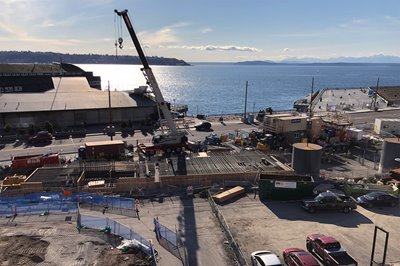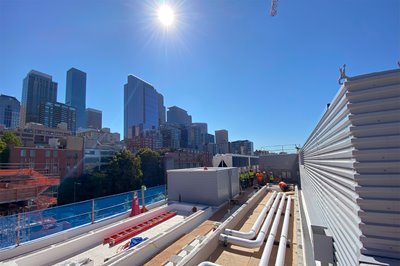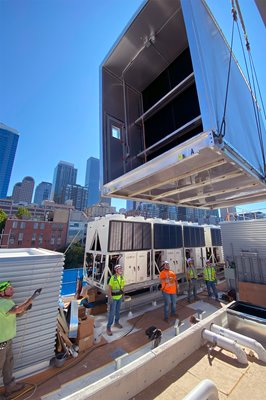 The Seattle Aquarium is undergoing its most ambitious expansion since its founding in 1962. The original aquarium highlights the Puget Sound ecosystem, and their new three-story Ocean Pavilion will be dedicated to warm water marine life.
The Seattle Aquarium is undergoing its most ambitious expansion since its founding in 1962. The original aquarium highlights the Puget Sound ecosystem, and their new three-story Ocean Pavilion will be dedicated to warm water marine life.
Seattle rerouted a major highway to accommodate the $756 million project. The main 325,000-gallon tank will include a viewing window that visitors can see from the walkway outside without buying a ticket.
“This is going be one of the most distinctive buildings on the waterfront in Seattle,” points out Jonathan Manfredonia, communications manager for The Hermanson Co., based in Kent, Washington. “Our waterfront is what we’re known for, so this is a very proud project to be part of.”
SMACNA member The Hermanson Co. is key to the project’s success. Hermanson worked with the general contractor on a previous project for the Tacoma Zoo and Aquarium, so they are familiar with the unique challenges of large aquariums. Precise temperature control is essential for keeping marine animals healthy. “We’re providing the water temperatures and support that the life safety system needs for the actual tanks themselves,” says Chris Howard, Hermanson’s sheet metal general superintendent.
The general contractor brought Hermanson into the planning process early on. “We had honest conversations about why and how we price, the square foot pricing and the challenges of making deliveries to the site,” Howard says. “Aquariums have a small footprint, but an immense amount of mechanical, electrical and plumbing work goes above the ceilings. It’s loaded per square foot.” To fit into the tight spaces, each trade can only bring in what they need for a day or two. “If we brought in a load of duct and we didn’t hang it quickly, then we would have loaded a floor that nobody could work on afterward.” All trades meet for weekly sessions to coordinate the work. Even a small delivery on the back of a pickup truck must be scheduled ahead of time.
The Seattle aquarium requires three main air handlers: the 28000 CFM primary supply air, the 3800 CFM DOAS supply and the exhaust/energy recovery AHU. Two rooftop heat pumps provide heating and cooling water for the entire building, with a capacity of 400 tons of cooling and 4000 MBH of heating. Thirty fan coil units provide adjustable heating and cooling to different zones throughout the aquarium. “A couple of areas in the building are multi-story,” says Project Manager Dane Brooks. “A space might be 30 feet tall with layers and layers of mechanical, electrical and plumbing work.” Hermanson is also installing 50 radiant conditioning units located at exterior glass walls to assist with heating and cooling spaces with significant glass exposure.
Hermanson will install about 45,000 pounds of galvanized and stainless-steel duct for the aquarium. They considered using aluminum until they consulted the SMACNA Duct Construction Standards manual. “Aluminum is less expensive, but when you look at the stiffening requirements, especially in the negative pressures, it was more cost-effective to go stainless,” Howard says. They are fabricating everything in-house for about 2,200 shop hours. Installation will bring about 5,300 field hours, and the detailing process required another 1,800 hours. 
The project is on schedule to be handed to the owner in January 2024, but don’t plan a visit to see the fish right away. After Hermanson is done, specialists will adjust the tanks and acclimate 3,500 coral reef plants and animals. The acclimation process will take about six months before the exhibits are ready for the public.
“We do a lot of offices and hospitals,” Howard says. “But every so often, we get a project like this. When it’s done, people will see the tanks and beautiful architecture and not have a clue what it took above the ceilings. I heard long ago that if they don’t see it, hear it or feel it, you’ve done a good job. There’s a lot of work, a lot of coordination and a lot of headaches to get one of these things through.” The results are worth the painstaking care. “It will be a jewel-type building in the Seattle, Washington area.”
